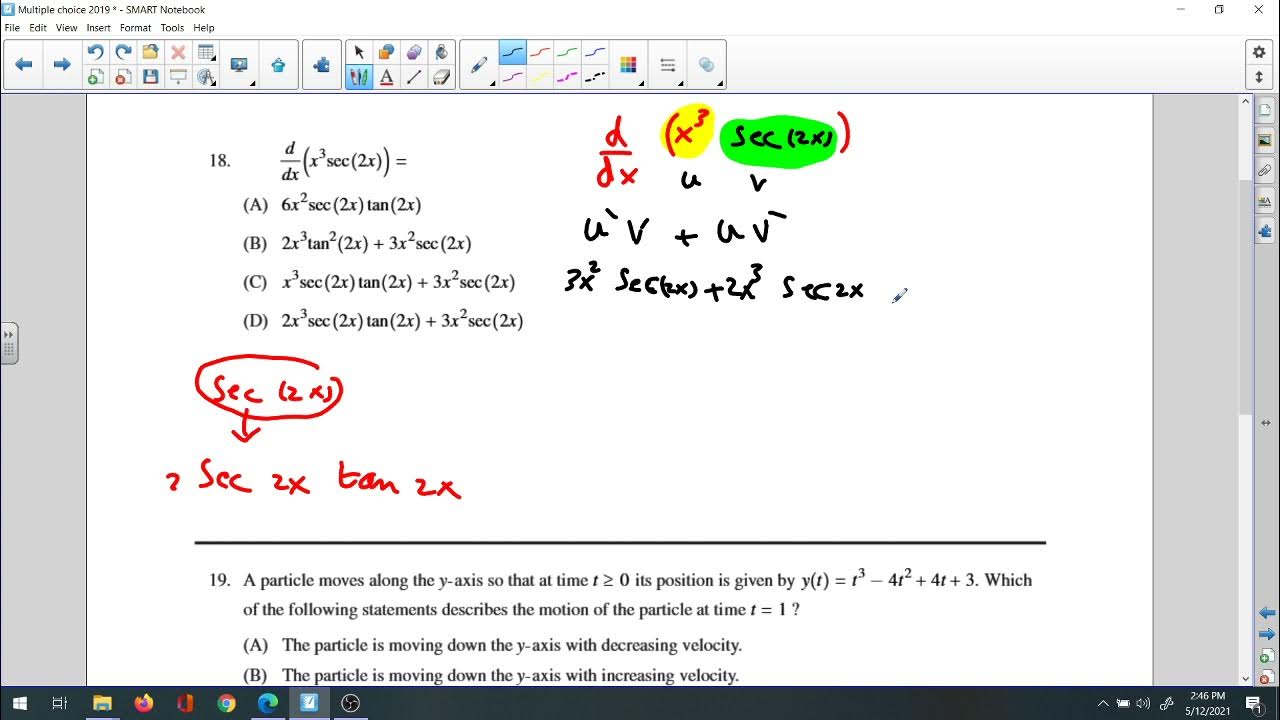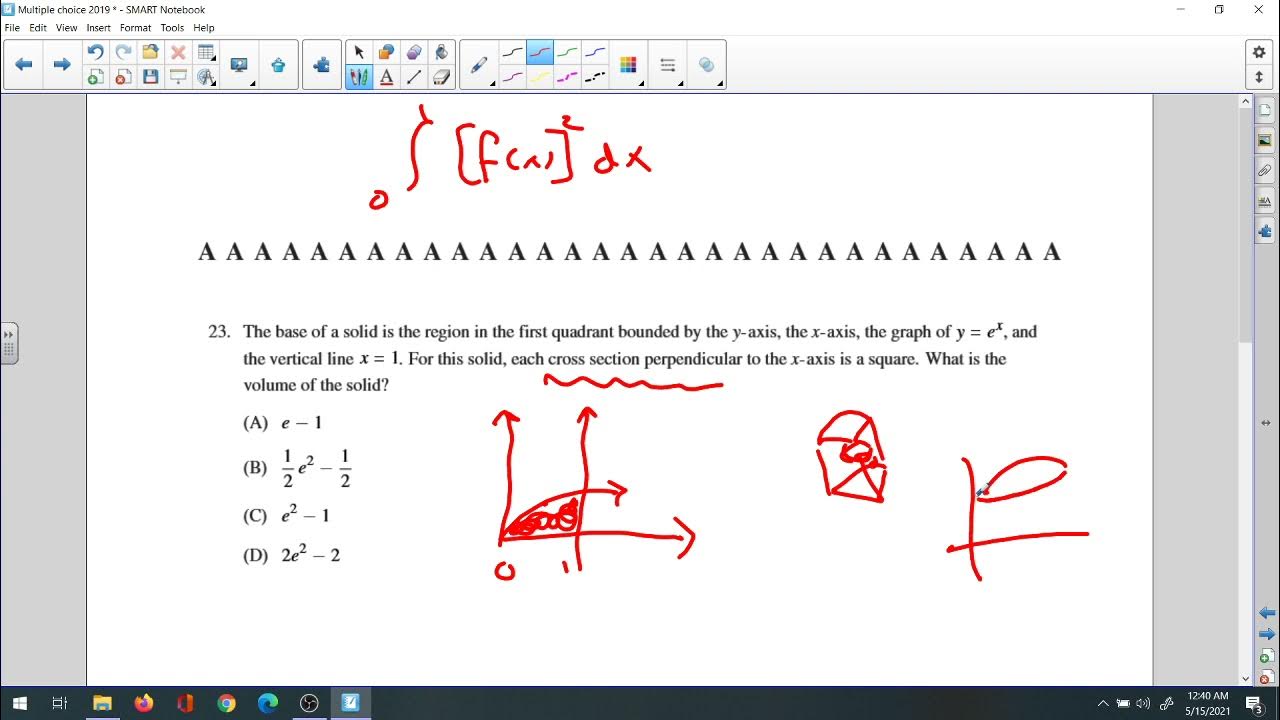2019 Multiple choices 1,2
TLDRThis video script offers a comprehensive review of the 2019 AP Calculus Multiple Choice exam, dissecting the complexity of the problems and providing insights into problem-solving strategies. It aims to engage viewers by highlighting key concepts tested, such as limits, derivatives, and integrals, and by offering tips for tackling the challenging questions that AP Calculus students might face. The summary is designed to pique interest in advanced mathematical concepts and to prepare students for the rigors of the AP exam.
Takeaways
- 📘 Thorough review of the 2019 AP Calculus Multiple Choice problems.
- 📊 Emphasis on understanding fundamental calculus concepts.
- 📝 Detailed breakdown of problem-solving strategies for each question.
- 📈 Explanation of common mistakes and how to avoid them.
- 🔍 In-depth analysis of specific problem types, including limits and derivatives.
- 🎯 Tips for improving speed and accuracy in answering multiple choice questions.
- 🔄 Importance of practicing with past papers to familiarize with the exam format.
- 🧮 Step-by-step solutions provided for complex problems.
- 📚 Resources recommended for further study and practice.
- 👍 Encouragement to focus on weaker areas and continuously assess progress.
Q & A
What topics are primarily covered in the 2019 AP Calculus Multiple Choice problems?
-The 2019 AP Calculus Multiple Choice problems cover topics such as limits, derivatives, integrals, and the Fundamental Theorem of Calculus.
How should students approach limit problems in the AP Calculus exam?
-Students should evaluate limits using techniques like factoring, rationalizing, and applying L'Hopital's Rule when appropriate.
What strategies are recommended for solving derivative problems in the exam?
-Students should use rules such as the power rule, product rule, quotient rule, and chain rule to find derivatives efficiently.
How can integrals be solved in the AP Calculus Multiple Choice section?
-Integrals can be solved using methods like substitution, integration by parts, and recognizing standard integral forms.
What is the significance of the Fundamental Theorem of Calculus in the exam?
-The Fundamental Theorem of Calculus connects differentiation and integration, allowing students to evaluate definite integrals and understand antiderivatives.
What are common mistakes to avoid when solving calculus problems on the AP exam?
-Common mistakes include algebraic errors, misapplying calculus rules, and not checking work for accuracy.
How important is time management during the AP Calculus Multiple Choice section?
-Time management is crucial; students should pace themselves, prioritize easier problems, and leave time to review their answers.
What resources are helpful for preparing for the AP Calculus exam?
-Helpful resources include review books, online practice exams, instructional videos, and tutoring sessions.
How can students improve their problem-solving skills for the AP Calculus exam?
-Students can improve by practicing a variety of problems, understanding underlying concepts, and seeking help for difficult topics.
What mindset should students adopt when approaching the AP Calculus exam?
-Students should remain calm, stay confident in their preparation, and approach each problem methodically to maximize their performance.
Outlines
📚 AP Calculus Review 2019
This paragraph focuses on reviewing multiple-choice problems from the 2019 AP Calculus exam. It suggests a need to revisit and analyze the types of questions that were asked, potentially to better understand the exam format and prepare for future tests. The year mentioned indicates a specific time frame for the review, which could be useful for educators and students alike.
Mindmap
Keywords
💡Limits
💡Derivatives
💡Integrals
💡Fundamental Theorem of Calculus
💡Chain Rule
💡Product Rule
💡Quotient Rule
💡Implicit Differentiation
💡Riemann Sum
💡Critical Points
Highlights
Insightful explanation of the Fundamental Theorem of Calculus.
Effective use of visual aids to explain concepts of limits and continuity.
Innovative method for solving complex integrals using substitution and integration by parts.
Clear distinction between different types of functions and their properties.
Comprehensive review of derivatives, including higher-order derivatives and their applications.
Detailed walkthrough of solving differential equations with initial conditions.
Explanation of the applications of calculus in real-world problems, such as physics and engineering.
Step-by-step approach to solving problems involving sequences and series.
Illustrative examples of Taylor and Maclaurin series.
Discussion on the importance of understanding the concept of continuity in calculus.
Practical tips for approaching multiple-choice questions efficiently.
In-depth analysis of common pitfalls and mistakes students make in calculus problems.
Use of technology and graphing calculators to solve calculus problems.
Strategies for optimizing the use of time during the AP Calculus exam.
Emphasis on the importance of practicing previous years' problems to gain familiarity with the exam format.
Transcripts
5.0 / 5 (0 votes)
Thanks for rating:





